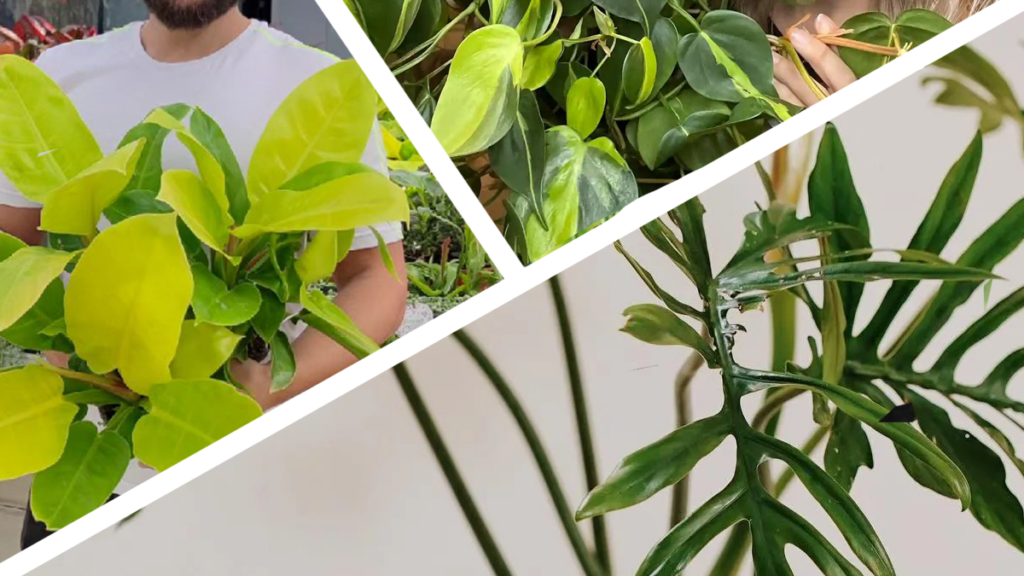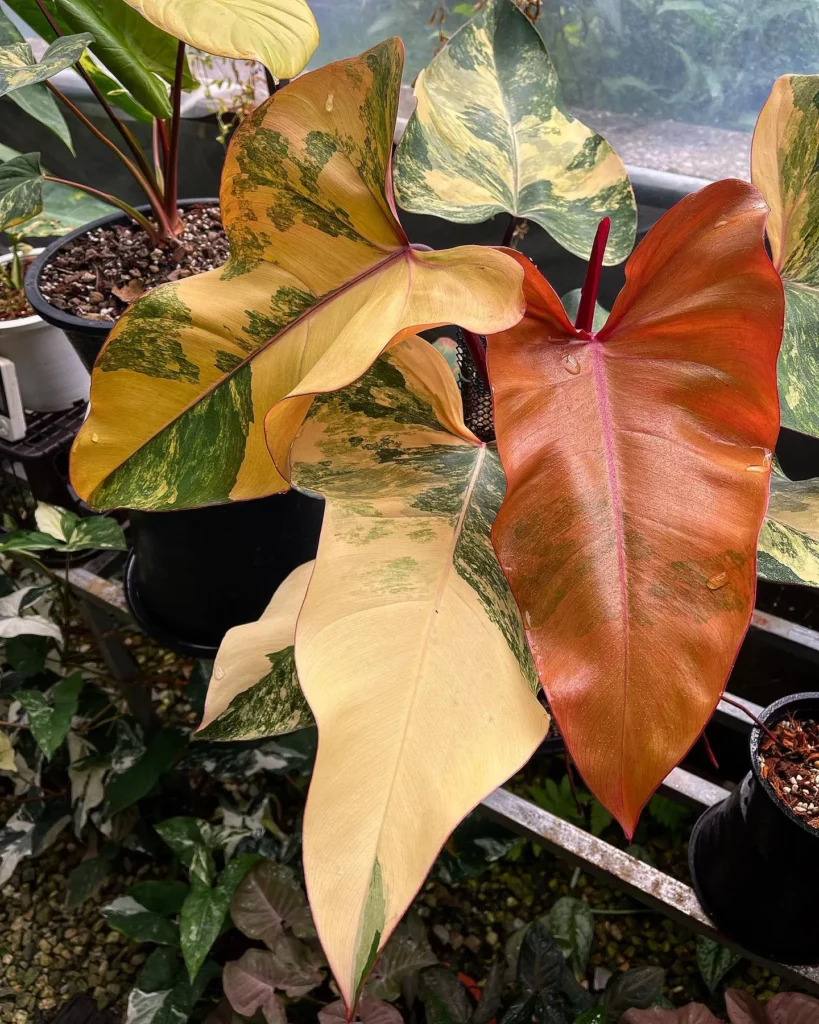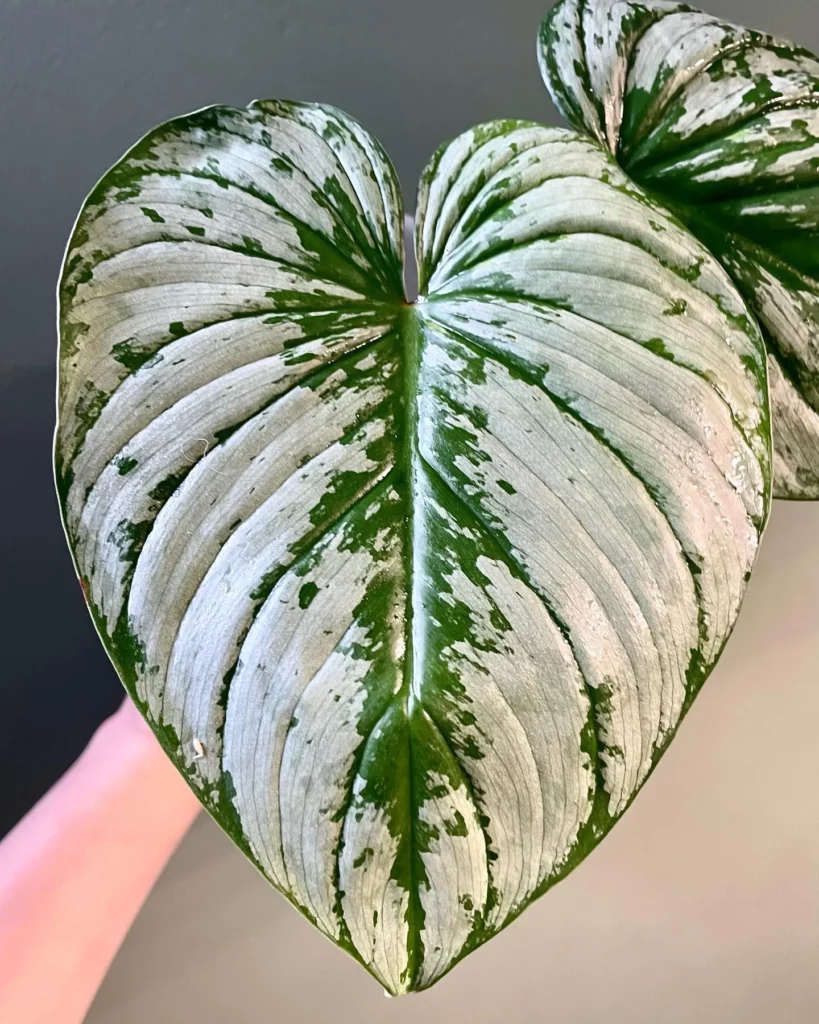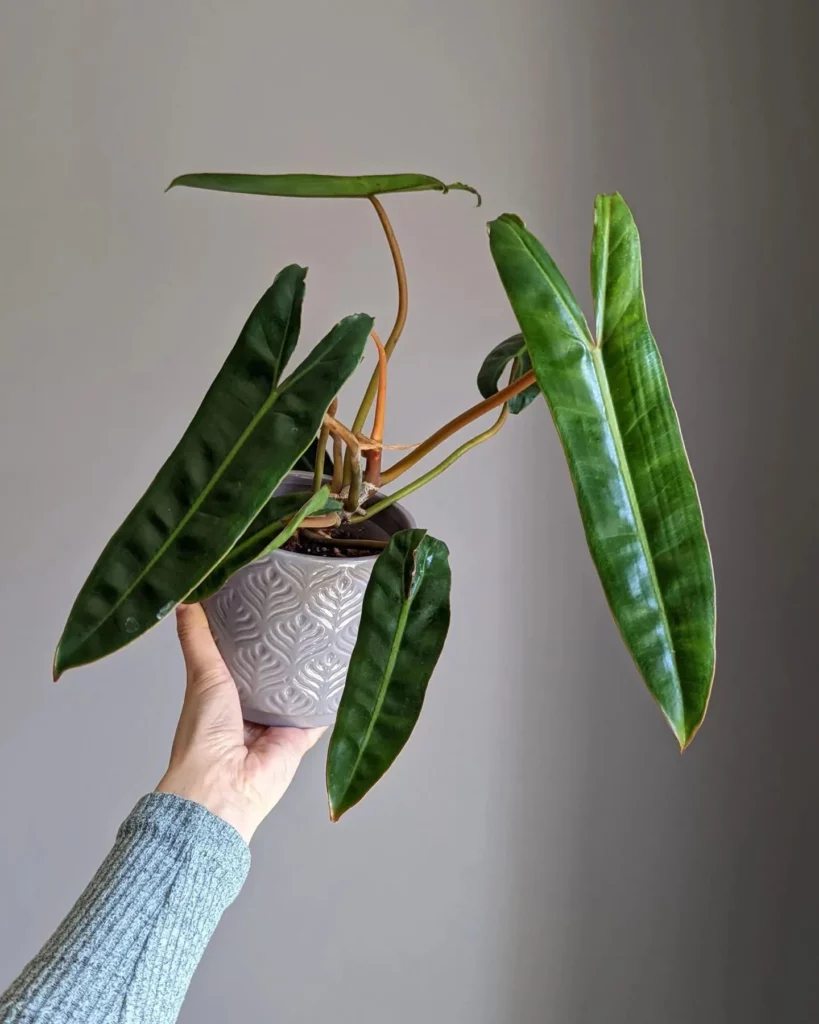Growing a beautiful and thriving indoor garden is a dream for many home gardeners. If you’re looking for an easy-to-grow plant that will bring life and beauty to your space, look no further than the Philodendron Hederaceum. Also known as the heart-leaf philodendron, this plant is perfect for both beginners and experienced gardeners. In this easy home gardening guide, I will share with you all the tips and tricks you need to know to successfully grow a superb Philodendron Hederaceum in your own home.
Key Takeaways:
- Growing a Philodendron Hederaceum is easy and suitable for all levels of gardening experience.
- The plant has heart-shaped leaves and a deep green color, adding beauty to any space.
- Philodendron Hederaceum thrives in indirect light and prefers well-drained soil.
Appearance of Philodendron Hederaceum



Philodendron Hederaceum is a stunning plant known for its unique appearance. It features heart-shaped leaves that add a touch of elegance to any indoor space. The leaves are a deep, rich green color, which enhances the overall beauty of the plant.
The climbing varieties of Philodendron Hederaceum have a trailing or climbing habit, creating a cascading effect that is visually pleasing. On the other hand, the upright types have larger leaves and a more compact growth habit, making them perfect for adding a statement to your home or office.
What sets Philodendron Hederaceum apart is the variety of leaf colors it can display. Depending on the specific cultivar, the leaves can range from blue/green to chartreuse/gold, gray/silver, or even purple/burgundy. This diversity adds a delightful splash of color to your indoor greenery.
No products found.
Light Requirements for Philodendron Hederaceum



One of the key factors in successfully growing Philodendron Hederaceum is providing the right amount of light. This houseplant thrives in indirect light, which makes it perfect for locations near windows but out of direct sunlight. Indirect light mimics the dappled light found in its natural habitat, resembling the gentle glow that filters through the canopy of a tropical rainforest.
It’s important to strike a balance with the light requirements of Philodendron Hederaceum. While it can tolerate a little more indirect light if it has leaves that are not all green, too much direct sunlight can cause the leaves to turn yellow. To ensure optimal growth and prevent any damage, it’s best to position your Philodendron Hederaceum in a spot where it can receive bright, indirect light throughout the day.
Factors to Consider:
- Place your Philodendron Hederaceum near windows to provide it with indirect light.
- Avoid exposing the plant to direct sunlight, as it can lead to yellowing of the leaves.
- Consider the color of the leaves when determining the amount of light the plant needs.
- Remember that Philodendron Hederaceum naturally grows in dappled light similar to a rainforest canopy.
Watering Philodendron Hederaceum



Proper watering is essential for the health and growth of Philodendron Hederaceum. To ensure optimal growth, it is important to maintain even moisture in the soil. Avoid overwatering, as this can lead to root rot and other water-related issues.
Water your Philodendron Hederaceum when the top inch of the soil feels dry to the touch. This will prevent waterlogging and promote healthy root development. It is best to water thoroughly, allowing the excess water to drain out from the bottom of the pot.
Here are some key tips for watering Philodendron Hederaceum:
- Use well-drained soil: Choose a potting mix that allows excess water to flow freely. This will prevent water from pooling around the roots.
- Avoid soggy soil: Philodendron Hederaceum does not like to sit in wet soil. Ensure proper drainage by using a pot with drainage holes and avoid overwatering.
- Monitor humidity levels: Philodendron Hederaceum prefers moderate to high humidity. If the air in your home is dry, consider using a humidifier or placing the plant on a pebble tray filled with water.
Fertilizing Philodendron Hederaceum


Proper fertilization is essential for the healthy growth of Philodendron Hederaceum. To ensure optimal nutrient supply, it is recommended to fertilize the plant monthly during the spring and summer months, when it is in its active growth phase.
Options for Fertilizing
There are two popular options for fertilizing Philodendron Hederaceum: liquid fertilizer and slow-release pellets. Liquid fertilizer can be diluted according to the manufacturer’s instructions and applied directly to the soil. Slow-release pellets, on the other hand, are pre-measured and can be inserted into the soil, where they gradually release nutrients over time.
Frequency of Fertilization
During the rest of the year, it is best to cut back on fertilizing to once every two months. This helps prevent over-fertilization, which can lead to nutrient imbalances and potential damage to the plant. It’s important to remember that Philodendron Hederaceum can be sensitive to excess fertilizer, so it’s better to err on the side of caution and apply less rather than more.
No products found.
Potting Philodendron Hederaceum
When potting Philodendron Hederaceum, it is crucial to choose a well-drained potting medium that allows excess water to flow freely. This helps prevent waterlogging and root rot, ensuring the plant stays healthy. A good potting mix for Philodendron Hederaceum consists of equal parts of peat moss, perlite, and organic compost. This combination provides the right balance of moisture retention and aeration.
It is recommended to repot Philodendron Hederaceum every two years. This allows the plant to have enough space for root expansion and prevents the accumulation of salt deposits in the soil. When repotting, gently remove the plant from its current container and shake off any excess soil. Place the plant in a slightly larger pot, ensuring the pot has drainage holes. Fill the pot with the prepared potting mix, covering the roots and patting it down gently. Water the plant thoroughly after repotting to help settle the soil.
During the repotting process, it is essential to flush the soil thoroughly with water. This helps remove any built-up salts, which can cause leaf burn. Run water through the soil until the water draining from the pot runs clear. This ensures that the plant will have a fresh start in its new potting mix, free from any mineral build-up that can harm its growth and overall health.
Propagation of Philodendron Hederaceum
One of the easiest ways to propagate Philodendron Hederaceum is through stem cuttings. To propagate from stem cuttings, start by taking a 5-inch portion of the stem that has at least one leaf and a node. Place the cutting in water, making sure the node is submerged. Roots will form from the node, and once they are about an inch long, the cutting can be transplanted into potting soil. Alternatively, you can directly plant the cutting in potting soil, dipping the bottom half in rooting hormone before planting. Keep the cutting moist but not wet, and roots and new leaves will develop in a few weeks.
Water Propagation
Water propagation is a popular method for propagating Philodendron Hederaceum. To propagate in water, remove a 5-inch stem cutting with a node and place it in a glass of water. Make sure the node is submerged. Change the water every few days to keep it fresh and prevent bacterial growth. Roots will start to grow from the node, and once they are about an inch long, you can transfer the cutting to a pot with well-draining soil.
Soil Propagation
Soil propagation is another option for propagating Philodendron Hederaceum. Take a stem cutting with a node and remove any leaves from the lower half. Dip the bottom half of the cutting in rooting hormone to encourage root development. Plant the cutting in a pot with well-draining soil, burying the node and a few inches of the stem. Keep the soil moist but not overly wet, and roots will develop over time. Once the cutting has rooted and new leaves have grown, you can treat it as a mature Philodendron Hederaceum plant.
Growth and Development of Philodendron Hederaceum
Philodendron Hederaceum is a plant that shows remarkable growth and development, especially in its climbing varieties. These plants have a natural tendency to grow long and leggy over time. However, with proper care and pruning, you can encourage new shoots and maintain a more compact and attractive appearance.
Pruning for Optimal Growth
To promote healthy growth and prevent the plant from becoming too leggy, regular pruning is necessary. Start by removing any yellow or dead leaves, ensuring that they are cut close to the main stem. This not only improves the plant’s aesthetics but also helps redirect energy to areas where new growth can occur.
When pruning Philodendron Hederaceum, focus on cutting back the longer and more stretched-out stems. Look for nodes, which are the small bumps on the stem where leaves and new shoots emerge. Trim just above a node, as this encourages new growth to sprout from that point. By selectively pruning the gawky growth, you can shape the plant and maintain a more compact form.
Training Philodendron Hederaceum to Climb
In addition to pruning, you can train Philodendron Hederaceum to climb up support poles or down the sides of containers. This not only enhances its visual appeal but also allows you to take advantage of vertical space. Encourage the plant to climb by gently tying its vines to a support structure using soft plant ties or twine. As the plant grows, continue securing the vines to guide them along the desired path.
Pests and Diseases of Philodendron Hederaceum
When it comes to caring for Philodendron Hederaceum, it’s important to be aware of potential pests and diseases that can affect this beautiful houseplant. While Philodendron Hederaceum is generally pest-free, it can be susceptible to common houseplant pests such as aphids, mealybugs, scales, and spider mites. These pests can cause damage to the leaves, stunt growth, and impact the overall health of the plant.
Here are some common houseplant pests that may affect your Philodendron Hederaceum:
- Aphids: These small, soft-bodied insects feed on the sap of the plant, causing leaves to curl and turn yellow.
- Mealybugs: Mealybugs are small, white, cotton-like insects that can be found on the leaves and stems. They suck the sap from the plant and can cause stunted growth and leaf drop.
- Scales: Scales are small, oval-shaped insects that attach themselves to the leaves and stems. They can cause yellowing of leaves and stunted growth.
- Spider Mites: Spider mites are tiny pests that are difficult to see with the naked eye. They feed on the underside of leaves, causing yellow stippling and webbing.
Prevention is Key
Preventing pest infestations is always better than dealing with them after they occur. Here are some tips to keep your Philodendron Hederaceum healthy and pest-free:
- Inspect new plants before bringing them home to ensure they are free from pests.
- Keep your plants clean by regularly wiping the leaves with a damp cloth to remove dust and potential pest eggs.
- Monitor the humidity levels around your plants, as some pests thrive in dry environments.
- Avoid overwatering your Philodendron Hederaceum, as excess moisture can attract pests.
- Give your plants enough space to prevent overcrowding, as this can create a favorable environment for pests.
Recommended Varieties of Philodendron Hederaceum
If you’re looking to add some variety to your collection of Philodendron Hederaceum, here are some recommended varieties that will surely catch your eye:
1. Philodendron ‘Brasil’
This variety of Philodendron Hederaceum features stunning yellow variegation on its leaves, adding a pop of color to any indoor space. The vibrant foliage of Philodendron ‘Brasil’ is sure to be a conversation starter and a beautiful addition to your home garden.
2. Philodendron domesticum
If you’re a fan of large, spade-shaped leaves, then Philodendron domesticum is the variety for you. Its impressive foliage will add a touch of elegance to your indoor garden, making it a true statement piece.
3. Philodendron bipennifolium
Also known as the lacy tree philodendron, Philodendron bipennifolium features intricate and delicate leaves reminiscent of lace. This variety adds a unique texture to your collection and will bring a sense of sophistication to any room.
Care Tips for Philodendron Hederaceum
When it comes to caring for your Philodendron Hederaceum, there are a few key points to keep in mind. Firstly, it’s important to note that this plant is toxic to both humans and pets, so be sure to position it out of reach. Additionally, regular pruning is essential for maintaining the plant’s health and appearance. Trim back any leggy growth to encourage new shoots to form and maintain a neat shape.
In terms of watering, Philodendron Hederaceum prefers even moisture but does not like to sit in wet soil. Water the plant when the top inch of the soil is dry, ensuring that it drains well. Overwatering can lead to root rot, so it’s important to strike a balance.
Fertilizing is also crucial for the growth and vitality of your Philodendron Hederaceum. Feed it with a balanced liquid fertilizer every month during the spring and summer months when it is actively growing. Reduce fertilization to once every two months during the rest of the year to avoid over-fertilization.
Key Care Tips for Philodendron Hederaceum:
- Position the plant out of reach of children and pets due to its toxic nature.
- Regularly prune to maintain the plant’s health and shape.
- Water when the top inch of soil is dry, ensuring good drainage.
- Fertilize monthly during the growing season and reduce to every two months in the off-season.
Conclusion
In conclusion, Philodendron Hederaceum is a fantastic choice for both beginner and experienced gardeners looking to add lush and thriving indoor greens to their homes. With its easy care requirements and stunning appearance, this plant is a must-have for any indoor garden.
By following the tips and tricks provided in this easy home gardening guide, you can ensure the successful growth of your Philodendron Hederaceum. Remember to provide the plant with the right amount of indirect light, water it appropriately, and fertilize it regularly. Choosing a well-drained potting medium and repotting every two years will also contribute to its overall health.
With its heart-shaped leaves, deep green color, and various varieties to choose from, Philodendron Hederaceum is a beautiful addition to any space. Whether you opt for Philodendron ‘Brasil,’ Philodendron domesticum, or Philodendron bipennifolium, these plants will undoubtedly bring a touch of beauty and vibrancy to your indoor garden.
So why wait? Get started on growing your superb Philodendron Hederaceum today and create a thriving and enchanting indoor oasis that you can enjoy for years to come.
FAQ
What is Philodendron Hederaceum?
Philodendron Hederaceum, also known as the heart-leaf philodendron, is an easy-to-grow houseplant with heart-shaped leaves and a deep green color.
What are the light requirements for Philodendron Hederaceum?
Philodendron Hederaceum prefers indirect light and dappled light, making it ideal for locations near windows but out of direct sunlight.
How should I water Philodendron Hederaceum?
Philodendron Hederaceum prefers even moisture and well-drained soil. Water the plant when the top inch of soil is dry to the touch.
How often should I fertilize Philodendron Hederaceum?
It is recommended to fertilize Philodendron Hederaceum monthly during the spring and summer months, using either liquid fertilizer or slow-release pellets.
What kind of potting medium should I use for Philodendron Hederaceum?
Choose a well-drained potting medium for Philodendron Hederaceum to avoid waterlogged soil. Repot the plant every two years to prevent salt build-up.
How can I propagate Philodendron Hederaceum?
Philodendron Hederaceum can be propagated through stem cuttings. Place the cutting in water or directly in potting soil, and new roots and leaves will develop.
How do I encourage growth in Philodendron Hederaceum?
Prune back leggy growth to promote new shoots. Philodendron Hederaceum can also be trained to climb up support poles or down the sides of containers.
What pests and diseases should I watch out for with Philodendron Hederaceum?
Common houseplant pests such as aphids, mealybugs, scales, and spider mites can affect Philodendron Hederaceum. Treat infestations with insecticidal soap or neem oil.
Are there different varieties of Philodendron Hederaceum?
Yes, there are several recommended varieties of Philodendron Hederaceum, including Philodendron ‘Brasil,’ Philodendron domesticum, and Philodendron bipennifolium.
What are some care tips for Philodendron Hederaceum?
Keep Philodendron Hederaceum out of reach of children and pets, prune regularly, and fertilize to maintain its health and appearance.




